|
|
As the year 2009 came to a close, it became apparent that with 47 homicides for the year, Richmond’s violence problem was getting worse. I asked that a “homicide summit” be placed on a City Council agenda in early 2010 to review in detail how the City of Richmond is deploying its anti-violence resources, which ultimately are under control of the City Council. Mayor McLaughlin agreed, and helped plan what became a single subject study session that occupied the City Council until midnight last Tuesday, March 23.
One of the questions I am most frequently asked is, “What is the City Council doing to stop the killing?” I don’t know if people really expect an answer or if this is simply their way of expressing their frustration and often their grief over friends and family members who have been murdered.
I think the short answer is that the City Council is doing everything it can, but that will never be enough. With a budget that has shrunk some $20 million since it was adopted in June 2009 at a level of $144 million, the City of Richmond spends a whopping $74 million on its Police Department, which has been maintained in the face of budget cuts everywhere else.
Poverty and misguided youth are at the core of Richmond’s homicide rate that often involves teenagers as young as 14 and 15. The City cannot end poverty, which is exacerbated by a recession driven unemployment rate that may be as high as 19%. Richmond does what it can, spending over $17 million annually in its Employment and Training efforts to prepare people and finds jobs for them.
Another $9 million is allocated for recreation in an effort to provide productive activities for young people. Add some $8 million for libraries and a half million for literacy programs.
That doesn’t leave a lot for fixing streets and keeping parks looking good, the subject of more complaints than homicides.
The final piece, the Office of Neighborhood Safety, which coordinates and collaborates with over two dozen government agencies and non-profits, uses innovative programs for outreach to persons inclined to violence. It is funded at less than $2 million, a substantial part of which is from state grants. This money, however small, remains coveted by a host of community activists who believe they can spend it with better results.
One thing that everyone agrees on is that Richmond’s worse violence is typically inflicted with guns by a relatively small group of young men, mostly African American, in a small area of concentrated poverty. In 2009, there were no homicides east of I-80 and south of I-580.
Over several hours, the Richmond Police Department and the Office of Neighborhood Safety provided the most detailed description of crime fighting and crime prevention in Richmond I have heard in my 15 years on the City Council.
Regardless of what the City Council does, the answer to reducing Richmond’s homicide rate lies in the community and its traditional organizations, including faith-based organizations, non-profits and schools, and ordinary people – neighbors, parents, grandparents teachers and pastors. The community has to be able to trust and cooperate with the police and develop a no-tolerance attitude towards violence, even if it involves family and friends. In the Richmond Police presentation last Tuesday, a video was shown of the new Shot Spotter system detecting a gun battle with 47 gunshots just off Cutting Boulevard at Stege. Not a single person called 911, and if it weren’t for Shot Spotter directing police to the exact location, one of the victims would have died.
In another presentation of the surveillance camera system, dispatchers watched a group of young men stomp a man into unconsciousness in the middle of a major street. Cars simply drove around the person as if he were a mattress fallen off a truck. No one stopped or provided assistance. This is the kind of community parts of Richmond have become.
Below is the agenda description for March 23. Ultimately, the City Council adopted three of the four items, leaving the daytime curfew for school children for another day. Three City Council members had objections to it.
STUDY AND DIRECTION TO STAFF SESSION
G-1. Hear presentations from the Richmond Police Department (Chris Magnus, Police Chief) and Office of Neighborhood Safety (DeVone Boggan, Director), and a Consortium of Richmond/West County service providers concerning: (1) existing programs and activities to reduce the incidence of violent crime in the Richmond community; and (2) recommended policies and actions for strengthening these efforts. Discuss and provide direction to staff regarding these policies, and consider the following actions:
- APPROVE a contract with the Contra Costa County District Attorney's Office for the dedicated services of a Deputy District Attorney who would specifically be assigned to handle Richmond gun-crime cases. This two-year contract would be for the period beginning April 5, 2010, through April 4, 2012, and would be for an amount not to exceed $290,000.00 (or $145,000.00 a year) - Police Department (Chief Chris Magnus 621-1802).
- b) INTRODUCE an ordinance (first reading) that makes it unlawful, with certain exceptions, for any minor subject to compulsory education to be in or upon any public street, highway, road, alley, park, playground, or other public ground, public place, place of amusement, eating establishment, or vacant lot 30 minutes after school commences until 30 minutes before school concludes on days when said minor's school is in session - Police Department (Chief Chris Magnus 621-1802).
- APPROVE the appointments of Councilmembers Bates and Viramontes as an ad hoc committee of two councilmembers to join the Richmond Police Department, other regional elected officials, and representatives from other designated agencies/organizations to meet with a group of Contra Costa County Superior Court Judges regarding sentencing practices for gun crimes - Mayor's Office (Mayor McLaughlin 620-6503).
- d) APPROVE the appointments of Mayor McLaughlin and Vice Mayor Ritterman as an ad hoc committee of two councilmembers to join the Richmond Police Department in meeting with the Contra Costa County District Attorney (or his designee) and Supervisor John Gioia to discuss prosecution issues related to gun crimes committed in Richmond - Mayor's Office (Mayor McLaughlin 620-6503).
Below are several media articles about the March 23 City Council Study Session and the topics it covered:
Richmond ready to aggressively prosecute weapons cases
By Karl Fischer
Contra Costa Times
Posted: 03/24/2010 12:03:50 PM PDT
Updated: 03/24/2010 09:16:18 PM PDT
A Smith & Wesson .357 Magnum handgun is among the items in the property locker at the police...
 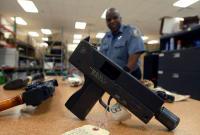 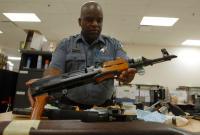
Many people carry weapons illegally in Richmond. But few go to jail.
Hoping to tilt that reality, the Police Department unveiled plans this week to aggressively prosecute misdemeanor weapons cases as a means to garner substantial prison time for repeat offenders.
"We attacked the drug problem as a way to get at street violence in the past," Capt. Alec Griffin told the City Council on Tuesday night. "But, across the country, law enforcement is shifting its focus more to violent crime and the gun offenders themselves."
Richmond police hope to follow suit, bringing prosecutors, Superior Court judges and Contra Costa County government into a formal dialogue about how to make minor gun charges stick as a means of building future felony cases.
Proposals to form regional committees of elected officials to meet with judges and prosecutors, as well as a two-year, $390,000 contract with the Contra Costa County District Attorney's Office to supply a full-time prosecutor exclusively for Richmond gun cases all won unanimous council approval by meeting's end.
Another plank of the department's violence-reduction plan, which would create a municipal daytime curfew for minors in Richmond, remained a point of contention. The council tabled it for a future meeting.
"This ordinance is, unfortunately, a bit premature," said Andres Soto, who sits on the governing board of the RYSE youth leadership center on Macdonald Avenue. "There's been very
little, if any, conversation within the organization or with the youth of Richmond about how to handle truancy. And I don't think it would do anything to improve police-youth relations."
Police Chief Chris Magnus had identified RYSE, along with the Richmond Police Activities League, as groups that could provide intake and counseling for truants picked up by police during school days. Police say Richmond's rampant truancy problem — it estimates that more than 100 city students cut school each day — directly correlates to daytime crime spikes, particularly youth-on-youth violence.
The gun plan dominated the discussion, however, with frank talk from deputy district attorney Mark Eichman about the difficulties of prosecuting weapons cases.
Prosecutors have great latitude to charge the most common firearms cases, such as possession of a concealed weapon, as misdemeanors or felonies.
But ancillary factors, such as the suspect's prior criminal history and whether the gun was loaded, often dictate a case's salability to judge and jury.
Judges also can change the severity of charges and their penalties.
"Typically, a police officer finds a concealed weapon on a person or a car. If the person has no prior criminal background, the District Attorney's Office has no choice but to file the case as a straight misdemeanor," Eichman said. "But the next time we catch them with a gun ... we've got something with some meat to it."
Prior weapons convictions improve chances of felony convictions and state prison time for repeat offenders. Law enforcement views removing chronic gun offenders for protracted periods as a more effective way of managing gun violence in Richmond, where last year police counted 370 nonfatal shootings along with 47 homicides, most committed with guns.
Local authorities say the vast majority of those attacks stem from disputes among an extremely small subset of the community.
"The ONS has identified 150 to 180 individuals who are at extreme risk of gun violence at any time," said DeVone Boggan, director of the Office of Neighborhood Safety.
Boggan's group attempts to deliver services and alternatives to those most at risk, and those most isolated from social norms, he explained during his presentation. He emphasized the ONS's partnerships with various community groups and stressed the need for greater collaboration in the city violence-prevention community.
Contact Karl Fischer at 510-262-2728. Follow him at Twitter.com/kfischer510.
Richmond considers school-time curfew for minors
City Council to weigh police proposal for daytime curfew, citations for violators
By Karl Fischer
Contra Costa Times
Posted: 03/22/2010 05:34:23 PM PDT
Updated: 03/23/2010 07:11:18 AM PDT
Any students caught wandering Richmond streets during class could soon face a Juvenile Court judge to explain their truancy if the City Council approves a school-day curfew proposed by the Police Department.
The plan, intended to curb the city's truancy problem and street violence that disproportionately affects the young, heads to the council Tuesday. If approved, minors found out of school during school hours would get a ticket.
"There are so many young people just hanging out in the streets of this city on a daily basis. I think people are really frustrated, and there's also a fair amount of concern for their welfare," police Chief Chris Magnus said. "Unfortunately, we're a long way from 'Ferris Bueller's Day Off.'"
The proposed ordinance is one piece of a larger plan to better coordinate anti-violence efforts in Richmond. The council also will hear from Magnus and DeVone Boggan, director of the Office of Neighborhood Safety, about forming regional committees of elected officials to meet with county judges and the Contra Costa District Attorney's Office about the prosecution and sentencing for gun crimes.
The Police Department also proposes a two-year, $290,000 contract with the district attorney to dedicate a prosecutor full time to Richmond gun cases. The prosecutor would work at the Richmond Police Department.
"Violence prevention is a multilayered effort, and I encourage all efforts in reducing crime and violence," Richmond Mayor Gayle McLaughlin said. "We must continue to deepen our collective effort, as a unified community, in conjunction with dedicated city departments, to bring about a peaceful and safe Richmond."
The truancy plan may reach furthest into the daily lives of average Richmond residents. Scores of children cut class daily, most from the city's four high schools and two middle schools, according to police. Juvenile Court can levy fines as high as $500, though the Police Department has yet to work out a penalty schedule with the courts.
Nearby Hercules and Pinole both enacted daytime curfews in recent years. In Hercules, an officer may write a $50 ticket for the first offense, a $100 ticket for a second offense and a $200 ticket for each subsequent offense.
Making truancy part of the municipal code, rather than relying solely on state educational code that requires students to attend school, adds teeth to the law, Hercules police Chief Fred Deltorchio said. Requiring families to interact with court and pay fines goes a long way toward emphasizing the need to take care of the problem at home.
"We had a rash of three or four residential burglaries involving students" in the months preceding the Hercules ordinance in summer 2008, Deltorchio said.
Law enforcement strongly correlates truancy with juvenile crime. In his report to the City Council, Magnus references pronounced drop in crime around Sacramento schools after that city enacted an active anti-truancy program, and a similar boost in attendance at San Francisco schools after a similar program started.
Data show that Richmond's highest rates of juvenile crime and juvenile victimization occur during school hours.
"We're seeing a lot of fairly serious crime, a lot of kids getting pulled into the juvenile justice system," Magnus said.
Richmond police now take truants back to school or wait with them for their parents. The process can be time consuming. The department periodically hosts focused truancy sweeps, with the Richmond Police Activities League serving as a drop-off center where students can wait for their parents or until the end of the school day.
The most recent sweep, from March 9 to 12, netted 425 Richmond students who were not in school when they should have been.
The ordinance would establish RPAL and another partner, likely the RYSE center, as permanent drop-off and counseling centers for truants. Logistical conversations continue with both groups, Magnus said.
Contact Karl Fischer at 510-262-2728. Follow him at Twitter.com/kfischer510.
If You Go
· WHAT: Richmond City Council meeting
· WHEN: 6:30 p.m. today
· WHERE: 440 Civic Center Plaza, Richmond
Richmond searches for answers to soaring homicide rate (http://www.healthycal.org/)
Published: March 20, 2010
By Heather Tirado Gilligan
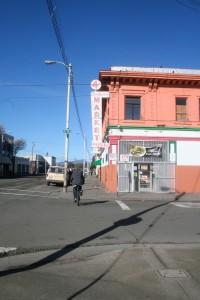
A corner store in Richmond's notorious Iron Triangle district, on once-lively MacDonald Ave. Photo by Heather Tirado Gilligan.
Even as murder rates are declining across California and the nation, homicide is on the rise in Richmond, the gritty industrial city on the east side of San Francisco Bay. A resident of Richmond is nearly three times as likely to be murdered as someone in Los Angeles, Sacramento or San Francisco.
In the last two months alone, Richmond has seen seven murders. This year’s crimes include the killing of a pregnant mother in a drive-by shooting February. Another February shooting shocked local residents and spectators statewide when teen-aged gunmen opened fire on two churchgoers, also teenagers, as the choir sang during Sunday services. And a murder of a toll-booth worker last year on the Richmond-San Rafael Bridge and the subsequent chase of the suspected shooter played out on television screen across the country.
The latest surge is a step back for the city after years of progress. Between 1991 and 2001 Richmond’s murder rate dropped from 69 killings for every 100,000 people to just 18. The rate has been rising steadily since then, except for a one-year dip in 2008. Last year there were 47 murders in the city of about 104,000 people.
What is at the heart of Richmond’s plight? The simple answer is poverty. Poverty and violence go together. Look at a map showing both of them and it is clear that murders occur almost exclusively in areas of high poverty. And Richmond is one of the poorest cities in the state.
But that simple answer doesn’t capture the real story in Richmond. People of all walks of life, from the government, law enforcement and the community, are trying new strategies to reduce the violence. The city is using ex-cons to reach out to at-risk “trigger-pullers.”
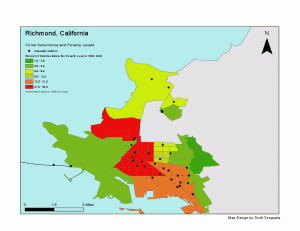
This map shows the correlation between homicide and poverty in the city of Richmond. Click on the map for a larger image.
The police are spending more time in the community. And religious and neighborhood groups are standing up to try to face down violent crime. Divisions remain about the best violence prevention strategies to employ, but people are united by their persistence, their refusal to step back and let crime rule their city.
“It’s not any surprise that the areas where we see most of the homicides in our city are the poorest areas of our city,” said Devone Boggan, director of Richmond’s Office of Neighborhood Safety. “But I’ll never buy into because I don’t have money I have a right to go shoot and kill someone.”
 Hear Devone Boggan in his own words. Hear Devone Boggan in his own words.
0:00 / 0:00DownloadRight-click and save as to download.

Devone Boggan, director of the Office of Neighborhood Safety
Poverty and Crime
People such as Boggan and the office he directs are rowing against a very strong tide. The improvement in overall national homicide numbers has obscured a rise in homicides among young black men, according to researchers James Allen Fox and Marc Swatt. Among young black men nationally, the homicide rate increased by 31 percent between 2001 and 2007, and the rate jumps to 54 percent for gun-related homicides.
“Richmond has had a serious violence problem for many, many years,” said Barry Krisberg, a senior fellow at the Center for Criminal Justice at Berkeley’s Boalt Law School. “What we see is that violence rises when you have concentrated and compacted poverty. Unlike other cities, Richmond is still characterized by really compacted poverty.”
Richmond Mayor Gayle McLaughlin agrees. “Poverty is clearly at the root of violence,” she said. “Racial injustice, social injustice are a part of the history of this city and all of this is part of the problem.”
Krisberg questions the effectiveness of crime preventions solutions undertaken outside of efforts to tame poverty. “It’s my opinion that cities have to reduce poverty if they want to see significant reductions in violence,” he said.
Looking for local answers
But people in Richmond refuse to accept that economics is destiny when it comes to violence. One possibility of change lies in the men the Office of Neighborhood Services employs as outreach workers—formerly incarcerated Richmond natives.
“We should build on the assets of those coming home from incarceration,” Boggan said. “For the city to take a step in actually hiring folks who have interesting pasts…and that’s a criteria for the work, I think is a positive step.”
ONS runs Richmond’s version of Project Ceasefire, a violence reduction program that originated in Boston. The city agency uses outreach workers to identify people who are most likely to offend, and tries to redirect them to resources in the community that can help them learn marketable skills and find work. The office identifies what they call “known-trigger pullers” in the community and targets them for services. They focus on young people aged 14-24.
Outreach workers like Sal Garcia, who was incarcerated in the late 1980s on a narcotics charge, share a similar background to the clients they reach out to on the streets. They also share a common pain. “The majority of people who are dying in Richmond are Latino and African American. Kids who look like me,” said Garcia.
 Hear Sal Garcia in his own words. Hear Sal Garcia in his own words.
0:00 / 0:00DownloadRight-click and save as to download.
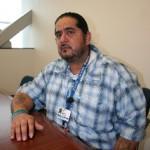
Sal Garcia is an outreach worker for the Richmond Office of Neighborhood Safety.
The outreach workers have a lifetime of experience dealing with the problems that drive at-risk young people to lives of crime, including losing family members to violence. “Back in ’92,” Garcia said, “I lost my brother.”
Reducing retaliation is key to their mission to reducing crime, outreach workers say. Outreach worker Sam Vaughn says that he participated in the wave of violence that plagued Richmond in the 1990s. He regrets his past, he said, especially after seeing his young nephew follow in his footsteps and end up in prison. Still, he draws on his past involvement in crime while reaching out to young people in Richmond, particularly when he talks to victim’s family members who may be thinking about revenge.
 Hear Sam Vaughn in his own words. Hear Sam Vaughn in his own words.
0:00 / 0:00DownloadRight-click and save as to download.
“When you have a young man that’s been murdered and you have his older brother who feels like I have to pay somebody back for this, for me watching my mom cry, or me realizing that my dad had to sell his truck to pay for the funeral, there’s anger and a lot of frustration involved in that, so you definitely want to engage people with those kinds of emotions,” Vaughn said.
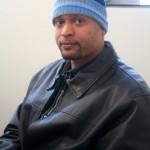
Sam Vaughn, Richmond outreach worker.
Vaughn and Garcia comprise half of the office’s staff of outreach workers. Garcia has worked for the office since 2007, when ONS was created, and Vaughn joined the staff in December 2009.
“It amazes me how large and ambitious the mandate is of this office and how the resources don’t match that mandate,” Boggan said. “You have an office of four outreach workers and one director. I think that’s a crime.” The office has been chronically underfunded: Richmond budgeted about $800,000 for ONS this year, $1.2 million short of what the city initially promised, Boggan said.
“That’s absolutely true,” Mayor McLaughlin said of the budget shortfalls at. She blames declining tax revenues and the state raiding of city coffers for the decreased city funding of violence prevention. “We could use a lot more neighborhood change agents,” she acknowledged.
But Andre Shumake, president of the Richmond Improvement Association, a faith-based organization working in violence prevention for the past 10 years, thinks ONS might be getting too much money already. No matter the amount of their resources, city agencies are ill-equipped to reach into the communities, a task most suited to grassroots organization like his own, he said.
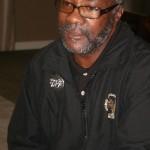
Andre Shumake, president of the Richmond Improvement Association, thinks neighborhood-based efforts against violence will be more effective than projects led by the government.
“For the most part, it’s our nieces, nephews, sons and daughters who are out there committing these crimes,” Shumake said. Because of these close connections, he advocates a community-generated approach to violence prevention. “People look at the problem and feel so overwhelmed and think it’s insurmountable,” Shumake said. “It’s not. It’s really not.”
When the Richmond homicide rate skyrocketed in 2006, Shumake worked with other faith-based organization to create what they called a tent city. Local residents camped out for 40 days and 40 nights, Shumake said, to call attention to the violence raging in the city, and to deepen community bonds. Richmond churches, including the Richmond Improvement Association, are mobilizing now to respond to the Feb. 14 church shooting by organizing marches and rallies that took place on Feb. 27 and March 5.
 Hear Andre Shumake in his own words. Hear Andre Shumake in his own words.
0:00 / 0:00DownloadRight-click and save as to download.
Mayor McLaughlin favors such a community-based approach, she said, specifically citing the outreach work of the churches. “That’s a very key piece, the community organizations.”
When the community speaks out against violence, she said, it shows people who might break the law “that the community will not tolerate that.” “We have decades of injustice to overcome,” McLaughlin said. “I feel very confident that we are going to show what an urban area struggling with violence can do.”
She said the police department is shifting its tactics as well, with two cops on a walking beat and a new bike patrol. Community policing is at the heart of the police department’s crime fighting strategy, said police spokeswoman Sgt. Bisa French. Officers work beats for at least a year, and during that time attend community events and meetings so residents who live on their beat can get to know them. The police department’s three substations are also a part of a community policing strategy, as they allow officers to spend more time in their assigned neighborhoods, French said.
Yet Garcia, one of the outreach workers, cited the police’s inability to connect with the community as part of the cycle of violence. Young people would welcome a police presence if they felt that the police were there to protect them. According to Garcia, young people often carry guns because they are afraid they will become victims if they don’t have a weapon. “These kids are asking for boundaries,” Garcia said. “If there is a presence out there, they know that they are safe.”
Garcia also challenged McLaughlin’s optimistic point of view, criticizing the district attorney for failing to pursue and prosecute homicide cases in Richmond. “Everybody knows who these individuals are,” Garcia said. “They feel they can get away with it.”
Children growing up witnessing violence are more likely be violent, a heartbreaking cycle that outreach workers see every day. “I see a lot of young men out there that are good kids. They have a heart, they have emotions, they have families, they love people,” Vaughn said. “But they really have seen the wrong things; people have told them they wrong things. They’ve dealt with pain that…a 12 and a 13 and a 14-year-old should never have to see.”
Focusing on young people is Richmond’s best hope, according to Krisberg. “Long-term, if you really want to reduce violence in Richmond, you have to focus on the young people, the children,” Krisberg said. “There must be a prevention component and a law-enforcement only approach is not going to do the trick.”
|








